HR Practices: Nestle's Recruitment, Selection, and Training Analysis
VerifiedAdded on 2021/02/20
|21
|4769
|38
Report
AI Summary
This report delves into how multinational companies, specifically Nestle, enhance their recruitment, selection, and training processes to meet international requirements. The research includes an introduction to globalization, the company's background, and the aims, objectives, and research questions guiding the study. A project management plan, encompassing cost, scope, time, quality, communication, risks, and resources, is outlined. The report utilizes a work breakdown structure and Gantt chart for project management. Small-scale research, including a quantitative questionnaire, is conducted, and data is interpreted and analyzed to provide insights into Nestle's HR practices. The findings highlight the importance of effective recruitment and selection methods, the use of both internal and external recruitment, and the need for talented employees to succeed in international markets. The report concludes with recommendations based on the research and analysis, offering suggestions for improving Nestle's recruitment and training processes.

Managing Small
business project
business project
Paraphrase This Document
Need a fresh take? Get an instant paraphrase of this document with our AI Paraphraser
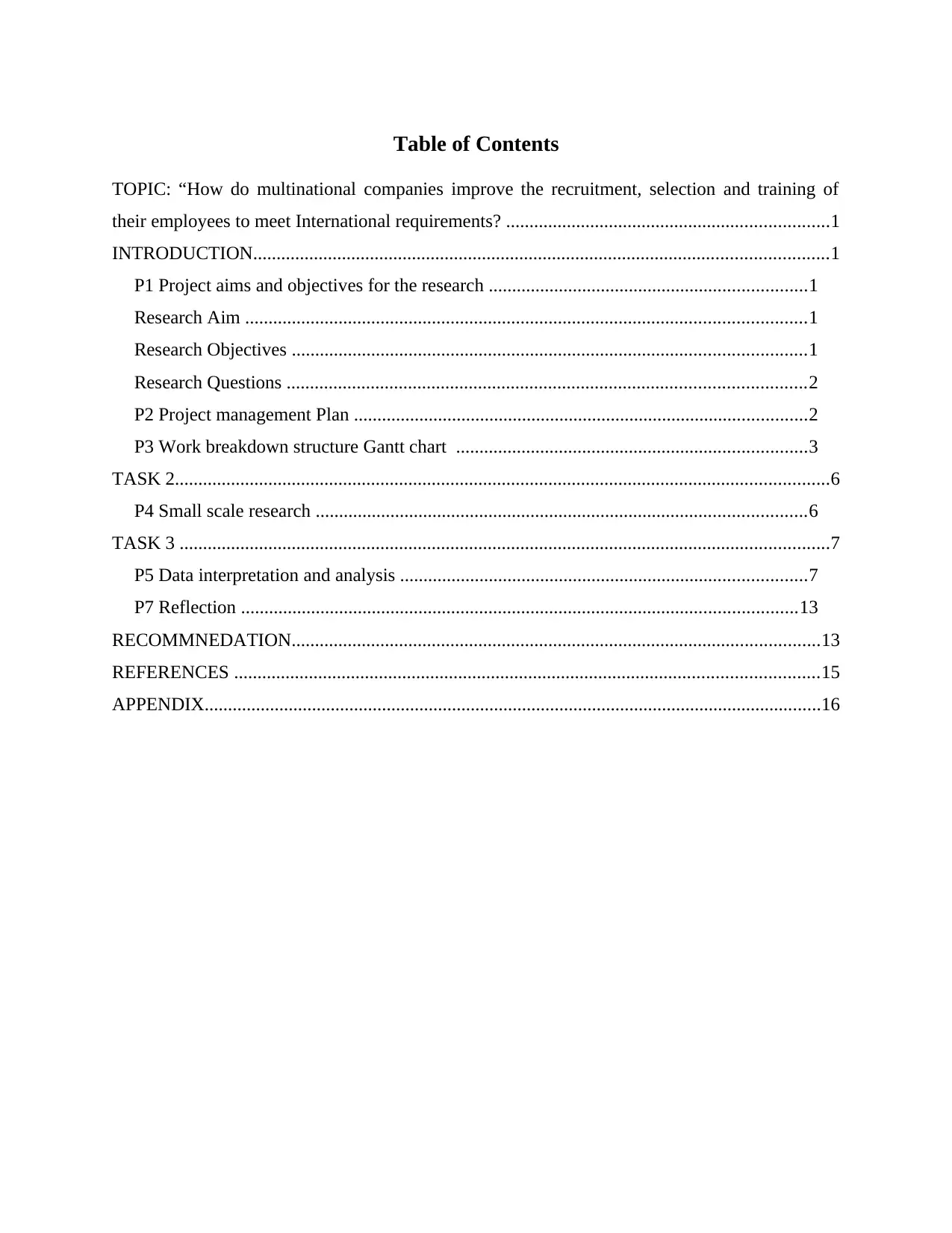
Table of Contents
TOPIC: “How do multinational companies improve the recruitment, selection and training of
their employees to meet International requirements? .....................................................................1
INTRODUCTION...........................................................................................................................1
P1 Project aims and objectives for the research ....................................................................1
Research Aim ........................................................................................................................1
Research Objectives ..............................................................................................................1
Research Questions ...............................................................................................................2
P2 Project management Plan .................................................................................................2
P3 Work breakdown structure Gantt chart ...........................................................................3
TASK 2............................................................................................................................................6
P4 Small scale research .........................................................................................................6
TASK 3 ...........................................................................................................................................7
P5 Data interpretation and analysis .......................................................................................7
P7 Reflection .......................................................................................................................13
RECOMMNEDATION.................................................................................................................13
REFERENCES .............................................................................................................................15
APPENDIX....................................................................................................................................16
TOPIC: “How do multinational companies improve the recruitment, selection and training of
their employees to meet International requirements? .....................................................................1
INTRODUCTION...........................................................................................................................1
P1 Project aims and objectives for the research ....................................................................1
Research Aim ........................................................................................................................1
Research Objectives ..............................................................................................................1
Research Questions ...............................................................................................................2
P2 Project management Plan .................................................................................................2
P3 Work breakdown structure Gantt chart ...........................................................................3
TASK 2............................................................................................................................................6
P4 Small scale research .........................................................................................................6
TASK 3 ...........................................................................................................................................7
P5 Data interpretation and analysis .......................................................................................7
P7 Reflection .......................................................................................................................13
RECOMMNEDATION.................................................................................................................13
REFERENCES .............................................................................................................................15
APPENDIX....................................................................................................................................16

⊘ This is a preview!⊘
Do you want full access?
Subscribe today to unlock all pages.

Trusted by 1+ million students worldwide
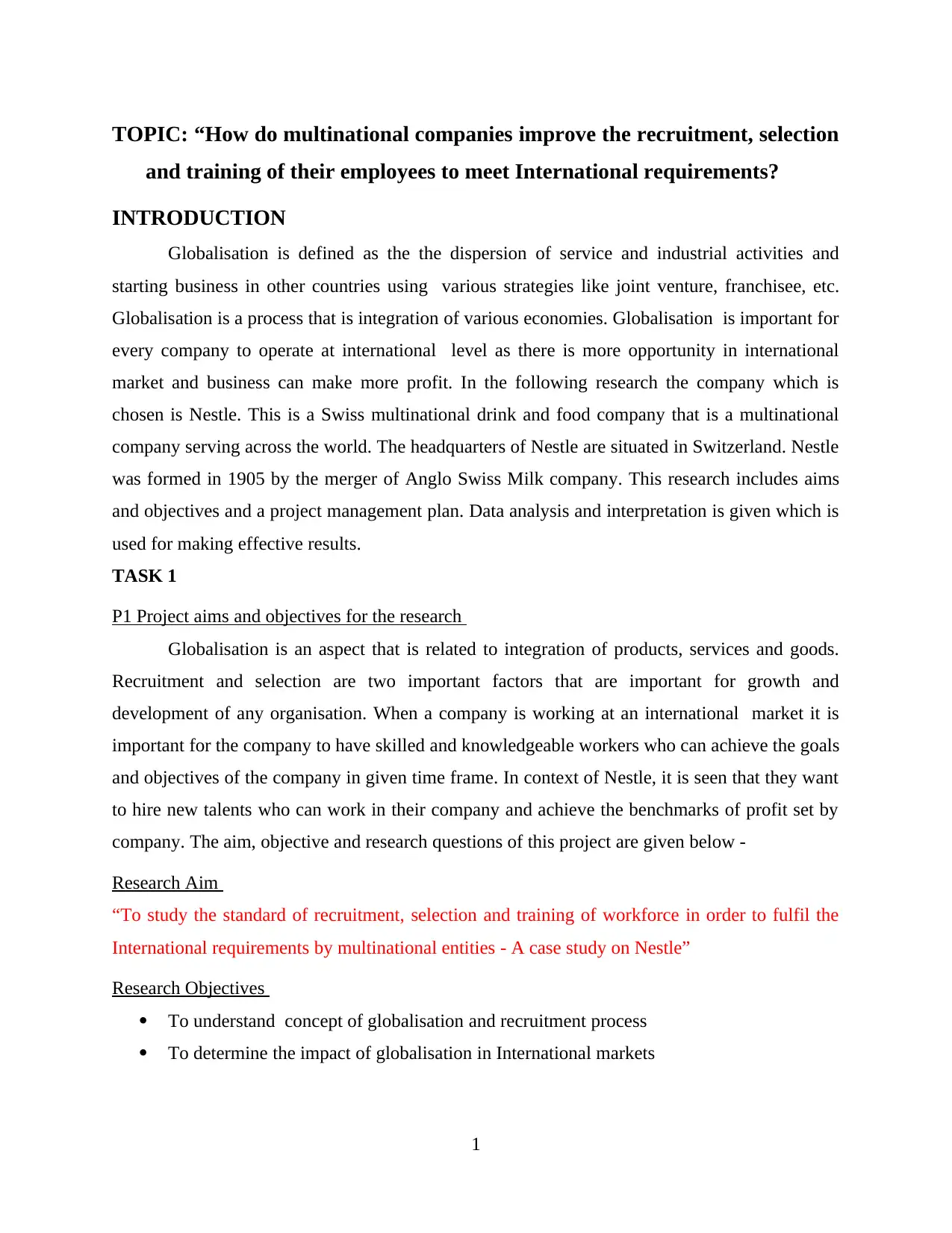
TOPIC: “How do multinational companies improve the recruitment, selection
and training of their employees to meet International requirements?
INTRODUCTION
Globalisation is defined as the the dispersion of service and industrial activities and
starting business in other countries using various strategies like joint venture, franchisee, etc.
Globalisation is a process that is integration of various economies. Globalisation is important for
every company to operate at international level as there is more opportunity in international
market and business can make more profit. In the following research the company which is
chosen is Nestle. This is a Swiss multinational drink and food company that is a multinational
company serving across the world. The headquarters of Nestle are situated in Switzerland. Nestle
was formed in 1905 by the merger of Anglo Swiss Milk company. This research includes aims
and objectives and a project management plan. Data analysis and interpretation is given which is
used for making effective results.
TASK 1
P1 Project aims and objectives for the research
Globalisation is an aspect that is related to integration of products, services and goods.
Recruitment and selection are two important factors that are important for growth and
development of any organisation. When a company is working at an international market it is
important for the company to have skilled and knowledgeable workers who can achieve the goals
and objectives of the company in given time frame. In context of Nestle, it is seen that they want
to hire new talents who can work in their company and achieve the benchmarks of profit set by
company. The aim, objective and research questions of this project are given below -
Research Aim
“To study the standard of recruitment, selection and training of workforce in order to fulfil the
International requirements by multinational entities - A case study on Nestle”
Research Objectives
To understand concept of globalisation and recruitment process
To determine the impact of globalisation in International markets
1
and training of their employees to meet International requirements?
INTRODUCTION
Globalisation is defined as the the dispersion of service and industrial activities and
starting business in other countries using various strategies like joint venture, franchisee, etc.
Globalisation is a process that is integration of various economies. Globalisation is important for
every company to operate at international level as there is more opportunity in international
market and business can make more profit. In the following research the company which is
chosen is Nestle. This is a Swiss multinational drink and food company that is a multinational
company serving across the world. The headquarters of Nestle are situated in Switzerland. Nestle
was formed in 1905 by the merger of Anglo Swiss Milk company. This research includes aims
and objectives and a project management plan. Data analysis and interpretation is given which is
used for making effective results.
TASK 1
P1 Project aims and objectives for the research
Globalisation is an aspect that is related to integration of products, services and goods.
Recruitment and selection are two important factors that are important for growth and
development of any organisation. When a company is working at an international market it is
important for the company to have skilled and knowledgeable workers who can achieve the goals
and objectives of the company in given time frame. In context of Nestle, it is seen that they want
to hire new talents who can work in their company and achieve the benchmarks of profit set by
company. The aim, objective and research questions of this project are given below -
Research Aim
“To study the standard of recruitment, selection and training of workforce in order to fulfil the
International requirements by multinational entities - A case study on Nestle”
Research Objectives
To understand concept of globalisation and recruitment process
To determine the impact of globalisation in International markets
1
Paraphrase This Document
Need a fresh take? Get an instant paraphrase of this document with our AI Paraphraser
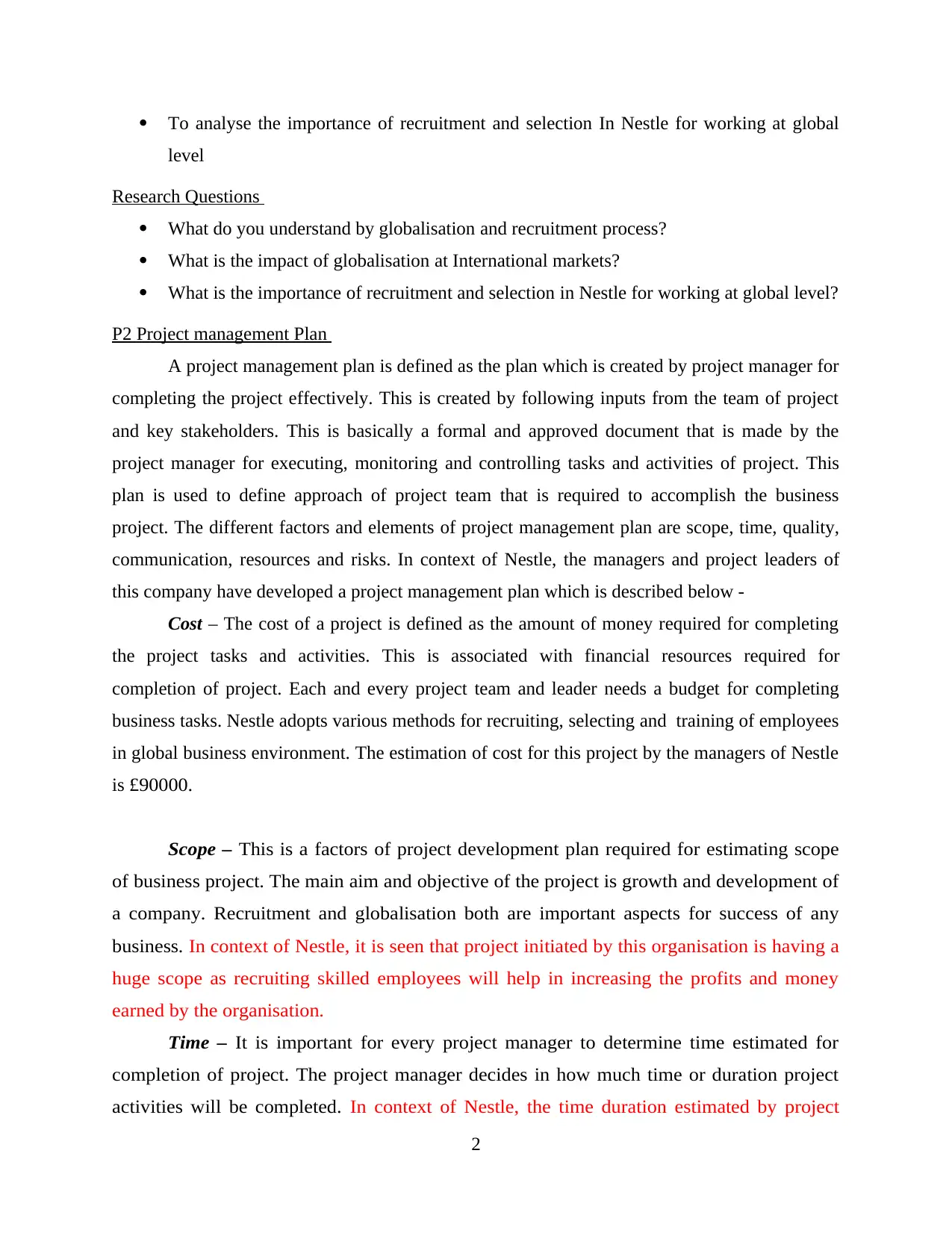
To analyse the importance of recruitment and selection In Nestle for working at global
level
Research Questions
What do you understand by globalisation and recruitment process?
What is the impact of globalisation at International markets?
What is the importance of recruitment and selection in Nestle for working at global level?
P2 Project management Plan
A project management plan is defined as the plan which is created by project manager for
completing the project effectively. This is created by following inputs from the team of project
and key stakeholders. This is basically a formal and approved document that is made by the
project manager for executing, monitoring and controlling tasks and activities of project. This
plan is used to define approach of project team that is required to accomplish the business
project. The different factors and elements of project management plan are scope, time, quality,
communication, resources and risks. In context of Nestle, the managers and project leaders of
this company have developed a project management plan which is described below -
Cost – The cost of a project is defined as the amount of money required for completing
the project tasks and activities. This is associated with financial resources required for
completion of project. Each and every project team and leader needs a budget for completing
business tasks. Nestle adopts various methods for recruiting, selecting and training of employees
in global business environment. The estimation of cost for this project by the managers of Nestle
is £90000.
Scope – This is a factors of project development plan required for estimating scope
of business project. The main aim and objective of the project is growth and development of
a company. Recruitment and globalisation both are important aspects for success of any
business. In context of Nestle, it is seen that project initiated by this organisation is having a
huge scope as recruiting skilled employees will help in increasing the profits and money
earned by the organisation.
Time – It is important for every project manager to determine time estimated for
completion of project. The project manager decides in how much time or duration project
activities will be completed. In context of Nestle, the time duration estimated by project
2
level
Research Questions
What do you understand by globalisation and recruitment process?
What is the impact of globalisation at International markets?
What is the importance of recruitment and selection in Nestle for working at global level?
P2 Project management Plan
A project management plan is defined as the plan which is created by project manager for
completing the project effectively. This is created by following inputs from the team of project
and key stakeholders. This is basically a formal and approved document that is made by the
project manager for executing, monitoring and controlling tasks and activities of project. This
plan is used to define approach of project team that is required to accomplish the business
project. The different factors and elements of project management plan are scope, time, quality,
communication, resources and risks. In context of Nestle, the managers and project leaders of
this company have developed a project management plan which is described below -
Cost – The cost of a project is defined as the amount of money required for completing
the project tasks and activities. This is associated with financial resources required for
completion of project. Each and every project team and leader needs a budget for completing
business tasks. Nestle adopts various methods for recruiting, selecting and training of employees
in global business environment. The estimation of cost for this project by the managers of Nestle
is £90000.
Scope – This is a factors of project development plan required for estimating scope
of business project. The main aim and objective of the project is growth and development of
a company. Recruitment and globalisation both are important aspects for success of any
business. In context of Nestle, it is seen that project initiated by this organisation is having a
huge scope as recruiting skilled employees will help in increasing the profits and money
earned by the organisation.
Time – It is important for every project manager to determine time estimated for
completion of project. The project manager decides in how much time or duration project
activities will be completed. In context of Nestle, the time duration estimated by project
2
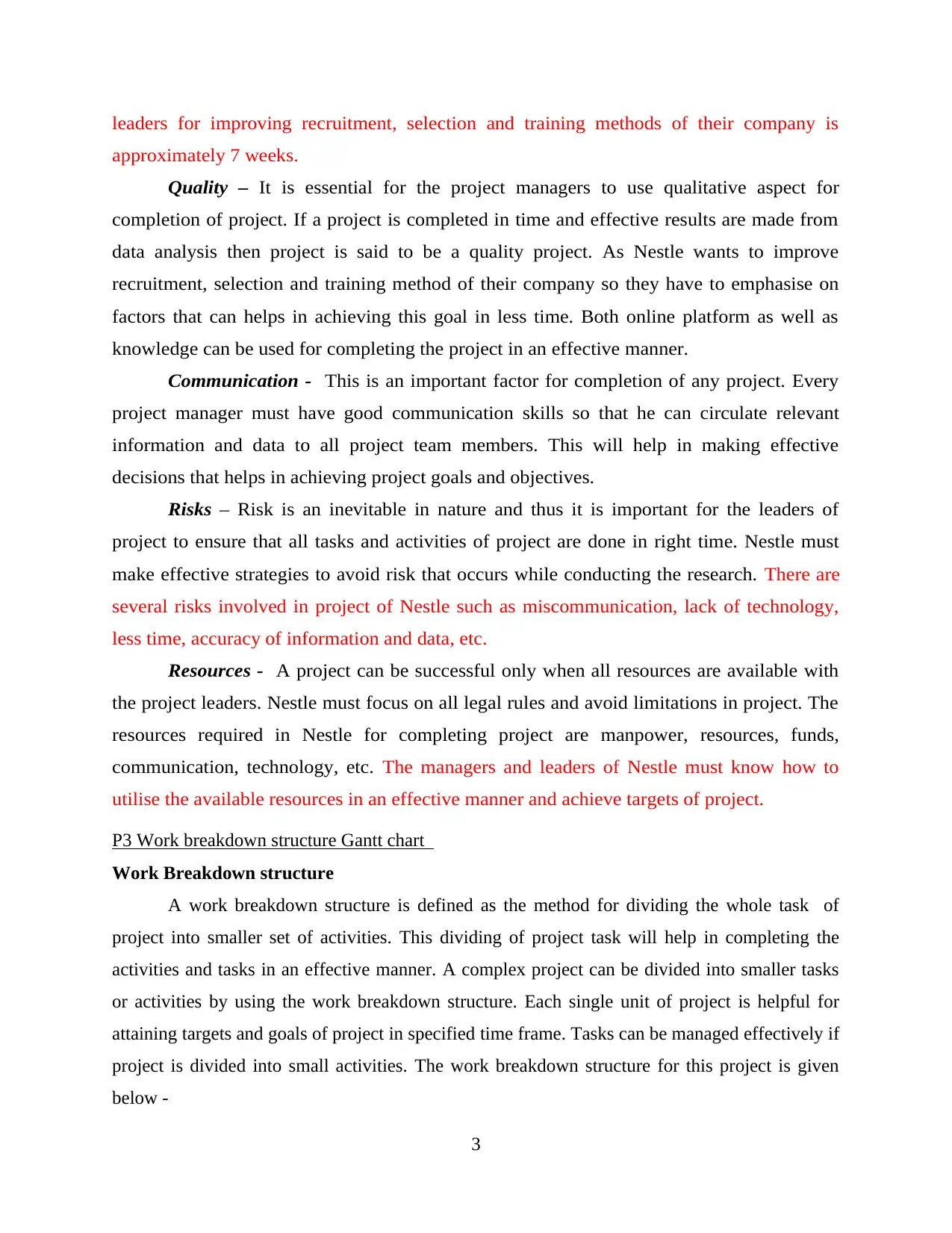
leaders for improving recruitment, selection and training methods of their company is
approximately 7 weeks.
Quality – It is essential for the project managers to use qualitative aspect for
completion of project. If a project is completed in time and effective results are made from
data analysis then project is said to be a quality project. As Nestle wants to improve
recruitment, selection and training method of their company so they have to emphasise on
factors that can helps in achieving this goal in less time. Both online platform as well as
knowledge can be used for completing the project in an effective manner.
Communication - This is an important factor for completion of any project. Every
project manager must have good communication skills so that he can circulate relevant
information and data to all project team members. This will help in making effective
decisions that helps in achieving project goals and objectives.
Risks – Risk is an inevitable in nature and thus it is important for the leaders of
project to ensure that all tasks and activities of project are done in right time. Nestle must
make effective strategies to avoid risk that occurs while conducting the research. There are
several risks involved in project of Nestle such as miscommunication, lack of technology,
less time, accuracy of information and data, etc.
Resources - A project can be successful only when all resources are available with
the project leaders. Nestle must focus on all legal rules and avoid limitations in project. The
resources required in Nestle for completing project are manpower, resources, funds,
communication, technology, etc. The managers and leaders of Nestle must know how to
utilise the available resources in an effective manner and achieve targets of project.
P3 Work breakdown structure Gantt chart
Work Breakdown structure
A work breakdown structure is defined as the method for dividing the whole task of
project into smaller set of activities. This dividing of project task will help in completing the
activities and tasks in an effective manner. A complex project can be divided into smaller tasks
or activities by using the work breakdown structure. Each single unit of project is helpful for
attaining targets and goals of project in specified time frame. Tasks can be managed effectively if
project is divided into small activities. The work breakdown structure for this project is given
below -
3
approximately 7 weeks.
Quality – It is essential for the project managers to use qualitative aspect for
completion of project. If a project is completed in time and effective results are made from
data analysis then project is said to be a quality project. As Nestle wants to improve
recruitment, selection and training method of their company so they have to emphasise on
factors that can helps in achieving this goal in less time. Both online platform as well as
knowledge can be used for completing the project in an effective manner.
Communication - This is an important factor for completion of any project. Every
project manager must have good communication skills so that he can circulate relevant
information and data to all project team members. This will help in making effective
decisions that helps in achieving project goals and objectives.
Risks – Risk is an inevitable in nature and thus it is important for the leaders of
project to ensure that all tasks and activities of project are done in right time. Nestle must
make effective strategies to avoid risk that occurs while conducting the research. There are
several risks involved in project of Nestle such as miscommunication, lack of technology,
less time, accuracy of information and data, etc.
Resources - A project can be successful only when all resources are available with
the project leaders. Nestle must focus on all legal rules and avoid limitations in project. The
resources required in Nestle for completing project are manpower, resources, funds,
communication, technology, etc. The managers and leaders of Nestle must know how to
utilise the available resources in an effective manner and achieve targets of project.
P3 Work breakdown structure Gantt chart
Work Breakdown structure
A work breakdown structure is defined as the method for dividing the whole task of
project into smaller set of activities. This dividing of project task will help in completing the
activities and tasks in an effective manner. A complex project can be divided into smaller tasks
or activities by using the work breakdown structure. Each single unit of project is helpful for
attaining targets and goals of project in specified time frame. Tasks can be managed effectively if
project is divided into small activities. The work breakdown structure for this project is given
below -
3
⊘ This is a preview!⊘
Do you want full access?
Subscribe today to unlock all pages.

Trusted by 1+ million students worldwide
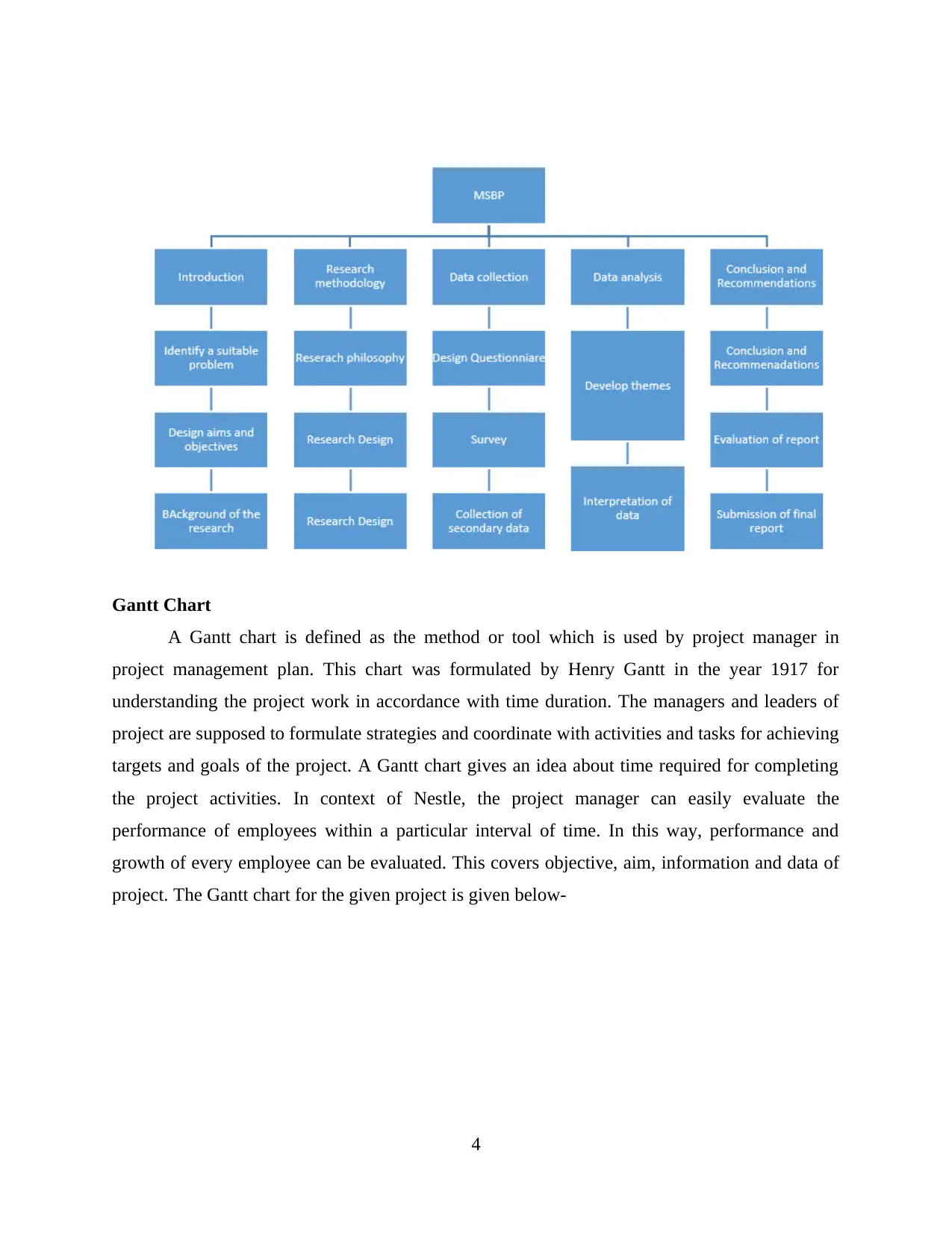
Gantt Chart
A Gantt chart is defined as the method or tool which is used by project manager in
project management plan. This chart was formulated by Henry Gantt in the year 1917 for
understanding the project work in accordance with time duration. The managers and leaders of
project are supposed to formulate strategies and coordinate with activities and tasks for achieving
targets and goals of the project. A Gantt chart gives an idea about time required for completing
the project activities. In context of Nestle, the project manager can easily evaluate the
performance of employees within a particular interval of time. In this way, performance and
growth of every employee can be evaluated. This covers objective, aim, information and data of
project. The Gantt chart for the given project is given below-
4
A Gantt chart is defined as the method or tool which is used by project manager in
project management plan. This chart was formulated by Henry Gantt in the year 1917 for
understanding the project work in accordance with time duration. The managers and leaders of
project are supposed to formulate strategies and coordinate with activities and tasks for achieving
targets and goals of the project. A Gantt chart gives an idea about time required for completing
the project activities. In context of Nestle, the project manager can easily evaluate the
performance of employees within a particular interval of time. In this way, performance and
growth of every employee can be evaluated. This covers objective, aim, information and data of
project. The Gantt chart for the given project is given below-
4
Paraphrase This Document
Need a fresh take? Get an instant paraphrase of this document with our AI Paraphraser
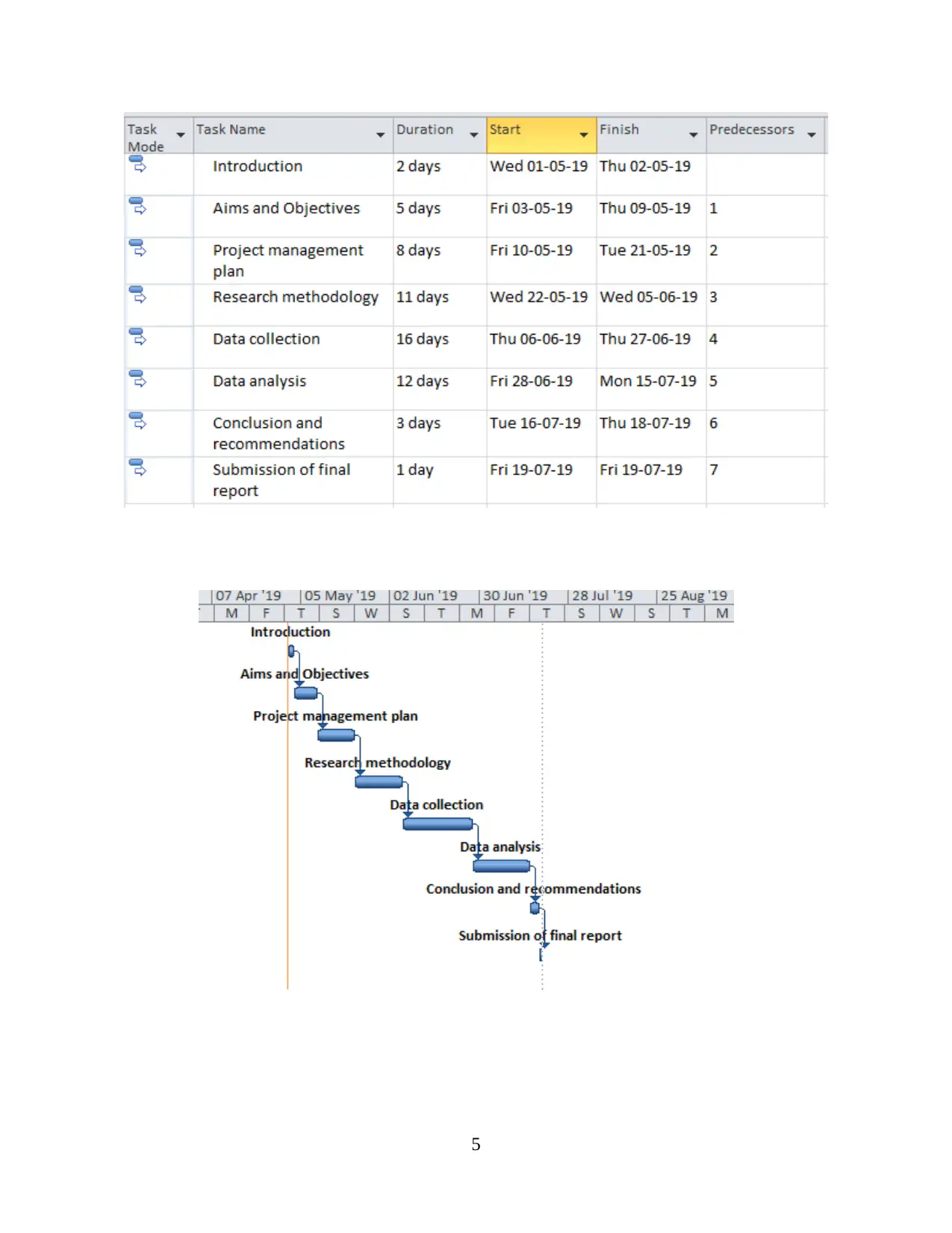
5
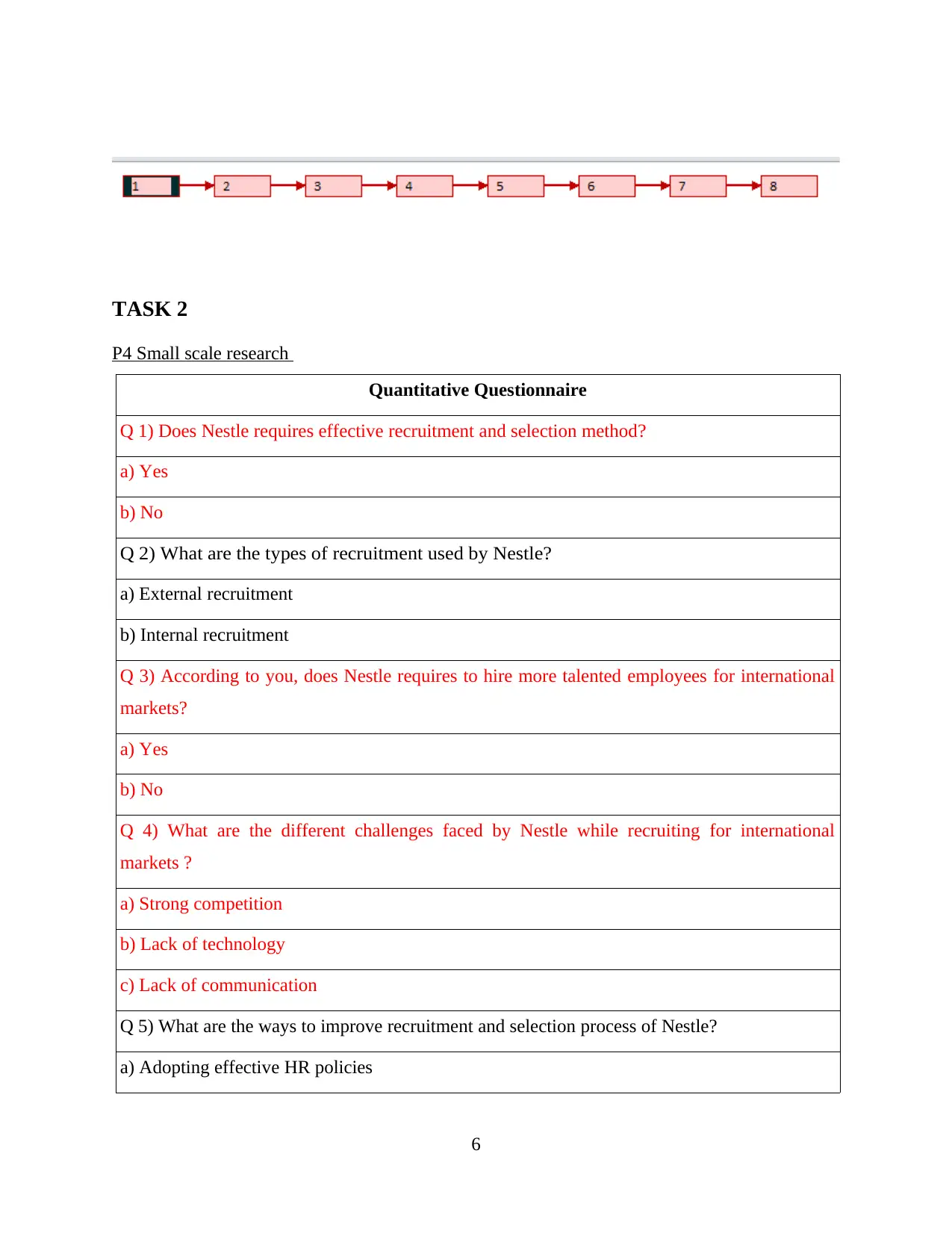
TASK 2
P4 Small scale research
Quantitative Questionnaire
Q 1) Does Nestle requires effective recruitment and selection method ?
a) Yes
b) No
Q 2) What are the types of recruitment used by Nestle?
a) External recruitment
b) Internal recruitment
Q 3) According to you, does Nestle requires to hire more talented employees for international
markets?
a) Yes
b) No
Q 4) What are the different challenges faced by Nestle while recruiting for international
markets ?
a) Strong competition
b) Lack of technology
c) Lack of communication
Q 5) What are the ways to improve recruitment and selection process of Nestle?
a) Adopting effective HR policies
6
P4 Small scale research
Quantitative Questionnaire
Q 1) Does Nestle requires effective recruitment and selection method ?
a) Yes
b) No
Q 2) What are the types of recruitment used by Nestle?
a) External recruitment
b) Internal recruitment
Q 3) According to you, does Nestle requires to hire more talented employees for international
markets?
a) Yes
b) No
Q 4) What are the different challenges faced by Nestle while recruiting for international
markets ?
a) Strong competition
b) Lack of technology
c) Lack of communication
Q 5) What are the ways to improve recruitment and selection process of Nestle?
a) Adopting effective HR policies
6
⊘ This is a preview!⊘
Do you want full access?
Subscribe today to unlock all pages.

Trusted by 1+ million students worldwide
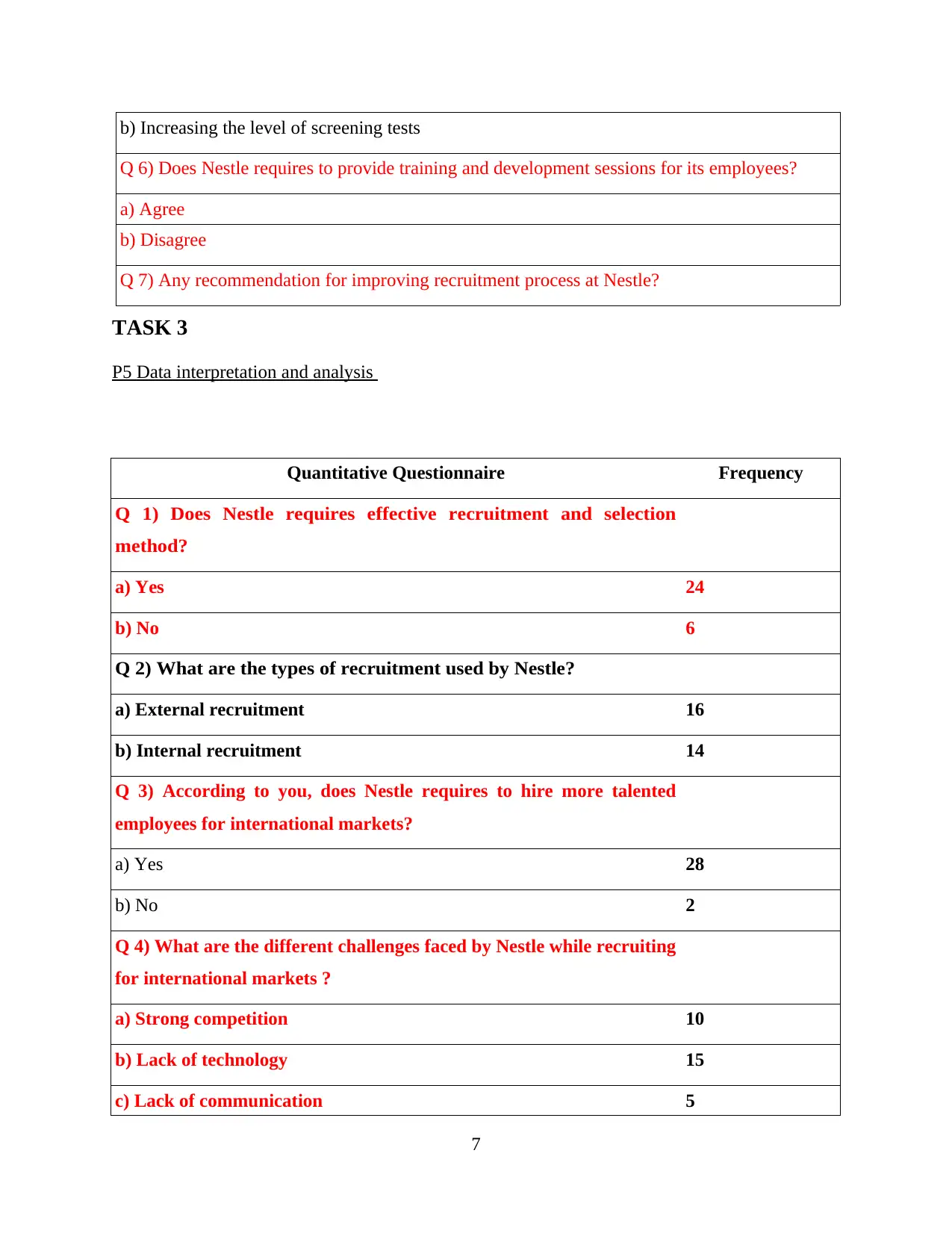
b) Increasing the level of screening tests
Q 6) Does Nestle requires to provide training and development sessions for its employees?
a) Agree
b) Disagree
Q 7) Any recommendation for improving recruitment process at Nestle?
TASK 3
P5 Data interpretation and analysis
Quantitative Questionnaire Frequency
Q 1) Does Nestle requires effective recruitment and selection
method?
a) Yes 24
b) No 6
Q 2) What are the types of recruitment used by Nestle?
a) External recruitment 16
b) Internal recruitment 14
Q 3) According to you, does Nestle requires to hire more talented
employees for international markets?
a) Yes 28
b) No 2
Q 4) What are the different challenges faced by Nestle while recruiting
for international markets ?
a) Strong competition 10
b) Lack of technology 15
c) Lack of communication 5
7
Q 6) Does Nestle requires to provide training and development sessions for its employees?
a) Agree
b) Disagree
Q 7) Any recommendation for improving recruitment process at Nestle?
TASK 3
P5 Data interpretation and analysis
Quantitative Questionnaire Frequency
Q 1) Does Nestle requires effective recruitment and selection
method?
a) Yes 24
b) No 6
Q 2) What are the types of recruitment used by Nestle?
a) External recruitment 16
b) Internal recruitment 14
Q 3) According to you, does Nestle requires to hire more talented
employees for international markets?
a) Yes 28
b) No 2
Q 4) What are the different challenges faced by Nestle while recruiting
for international markets ?
a) Strong competition 10
b) Lack of technology 15
c) Lack of communication 5
7
Paraphrase This Document
Need a fresh take? Get an instant paraphrase of this document with our AI Paraphraser
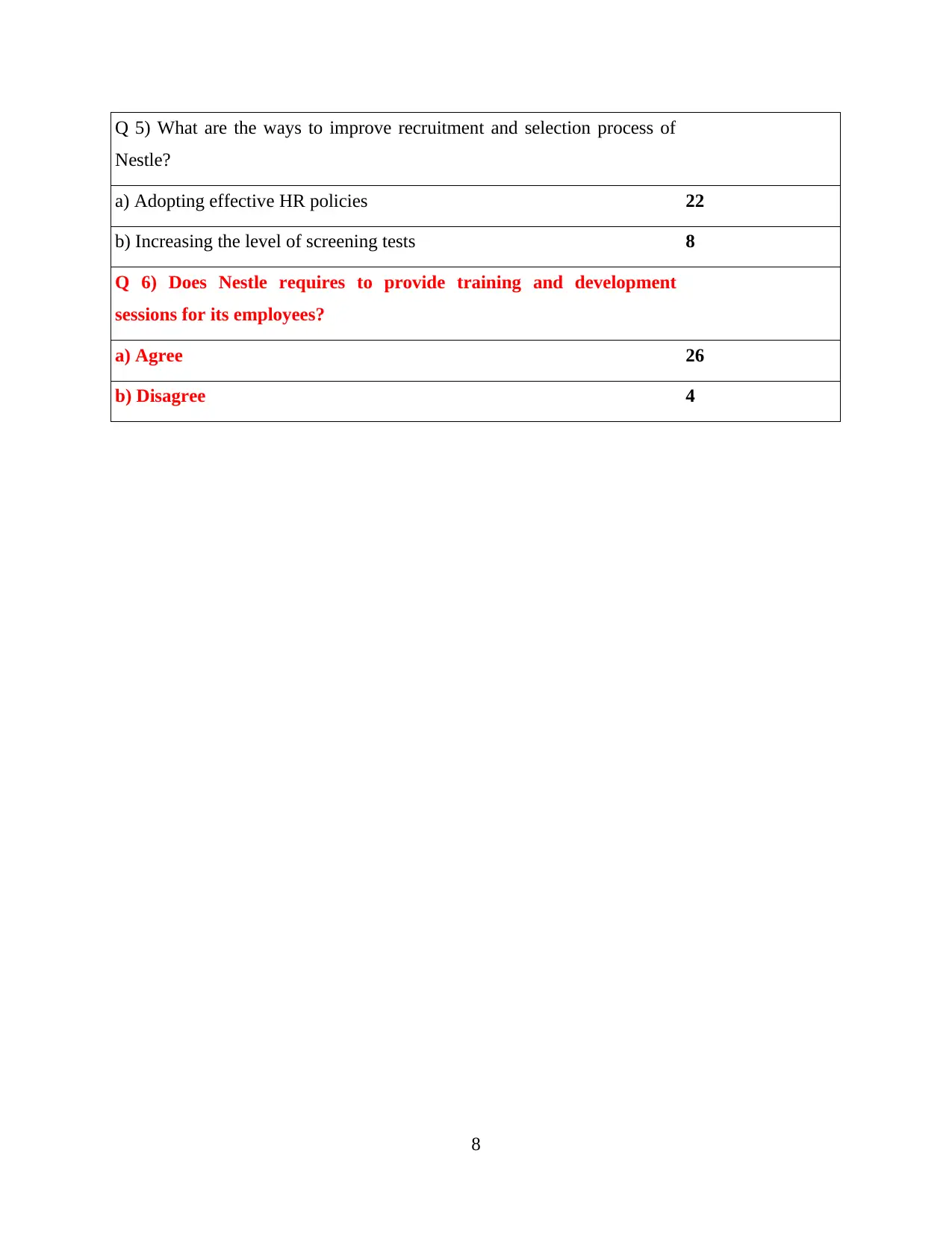
Q 5) What are the ways to improve recruitment and selection process of
Nestle?
a) Adopting effective HR policies 22
b) Increasing the level of screening tests 8
Q 6) Does Nestle requires to provide training and development
sessions for its employees?
a) Agree 26
b) Disagree 4
8
Nestle?
a) Adopting effective HR policies 22
b) Increasing the level of screening tests 8
Q 6) Does Nestle requires to provide training and development
sessions for its employees?
a) Agree 26
b) Disagree 4
8
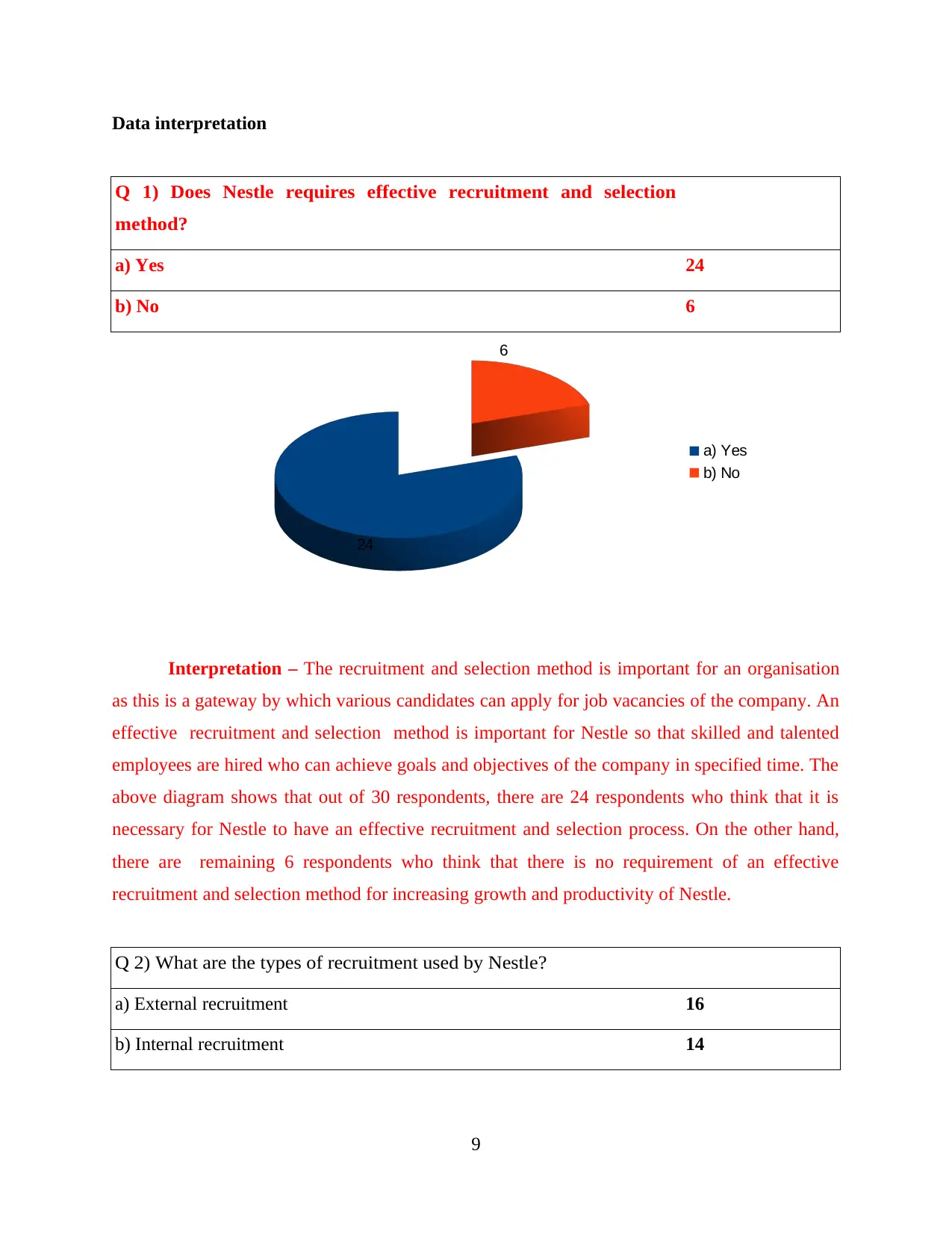
Data interpretation
Q 1) Does Nestle requires effective recruitment and selection
method?
a) Yes 24
b) No 6
Interpretation – The recruitment and selection method is important for an organisation
as this is a gateway by which various candidates can apply for job vacancies of the company. An
effective recruitment and selection method is important for Nestle so that skilled and talented
employees are hired who can achieve goals and objectives of the company in specified time. The
above diagram shows that out of 30 respondents, there are 24 respondents who think that it is
necessary for Nestle to have an effective recruitment and selection process. On the other hand,
there are remaining 6 respondents who think that there is no requirement of an effective
recruitment and selection method for increasing growth and productivity of Nestle.
Q 2) What are the types of recruitment used by Nestle?
a) External recruitment 16
b) Internal recruitment 14
9
24
6
a) Yes
b) No
Q 1) Does Nestle requires effective recruitment and selection
method?
a) Yes 24
b) No 6
Interpretation – The recruitment and selection method is important for an organisation
as this is a gateway by which various candidates can apply for job vacancies of the company. An
effective recruitment and selection method is important for Nestle so that skilled and talented
employees are hired who can achieve goals and objectives of the company in specified time. The
above diagram shows that out of 30 respondents, there are 24 respondents who think that it is
necessary for Nestle to have an effective recruitment and selection process. On the other hand,
there are remaining 6 respondents who think that there is no requirement of an effective
recruitment and selection method for increasing growth and productivity of Nestle.
Q 2) What are the types of recruitment used by Nestle?
a) External recruitment 16
b) Internal recruitment 14
9
24
6
a) Yes
b) No
⊘ This is a preview!⊘
Do you want full access?
Subscribe today to unlock all pages.

Trusted by 1+ million students worldwide
1 out of 21
Related Documents
Your All-in-One AI-Powered Toolkit for Academic Success.
+13062052269
info@desklib.com
Available 24*7 on WhatsApp / Email
![[object Object]](/_next/static/media/star-bottom.7253800d.svg)
Unlock your academic potential
Copyright © 2020–2025 A2Z Services. All Rights Reserved. Developed and managed by ZUCOL.





